What to do if lemon leaves fall
Lemon takes root well in a pot at home. He is even able to bloom and bear fruit in the apartment. Despite the fact that even a beginner citrus grower is able to cope with the cultivation of citrus, the plant is demanding in terms of care and growing conditions. If they are violated, it begins to hurt and dies.
One of the most obvious and dangerous symptoms of a plant feeling uncomfortable is leaf fall. Citruses are evergreens and such a phenomenon is not typical for healthy trees. The cause of the problem may lie in the violation care rules or damage to the plant by pests. How to identify the cause and save the lemon - read on.
The content of the article
Falling leaves due to care errors
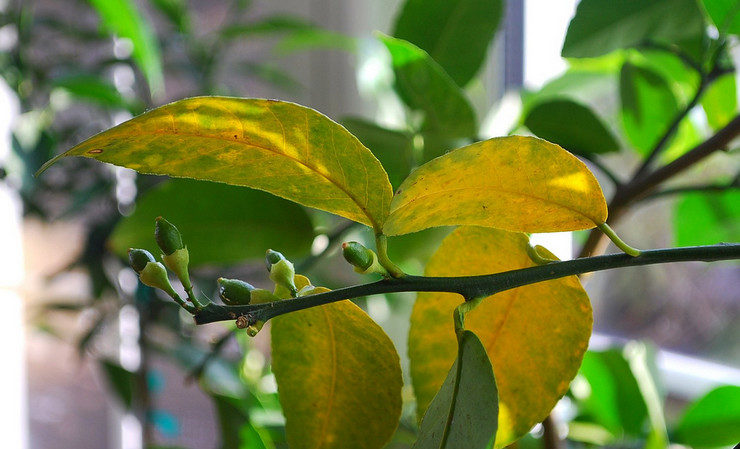
For evergreen lemon, massive leaf fall is unusual. It is normal for 1-2 leaves to fall, since the life span of one leaf plate is on average 3 years. Thus, the lemon leaves fall off one by one, and new greens grow in their place.
If the plant begins to fly around en masse, this indicates that it is experiencing severe stress. Often this is due to a violation of the rules for caring for him. To understand what to do if a lemon has leaves falling, it is worth understanding the reasons for this phenomenon.
Why Lemon Sheds Leaves:
- The room is too hot or too cold... Lemon is not suitable for extremely hot or cold climates. The permissible temperature for citrus plants varies between + 18 ... + 27 ° C. Optimum values are + 21 ... + 24 ° C.
- Sudden temperature changes. Lemon can't stand it. If you bring it to new conditions without preliminary hardening, it will begin to shed its leaves. Exposure to drafts is equally dangerous.
- Stagnant fluid. With excessive watering, lack of drainage and drainage holes, stagnant fluid occurs. The soil changes its composition, it no longer receives a sufficient amount of oxygen. The roots of the plant begin to rot and fall off. This is reflected in the crown.
- Overdrying the soil. With insufficient watering, the earthen lump cracks. The roots do not receive moisture and nutrients. They start to dry out and break off. This leads to the death of the plant.
- Using ice water for irrigation. Citrus fruits are watered only with water at room temperature. When using a liquid whose temperature is significantly different from the soil, the plant experiences stress, which provokes the leaves to fall.
- Soil depletion... Leaves, flowers and fruits are formed simultaneously on the lemon. Therefore, during the growing season, the plant consumes a large amount of nutrients. With a deficiency of any of them, foliage suffers. First, spots appear on it, then it dries and curls, and then falls off. A similar problem arises if the lemon has not been transplanted for a long time. Insoluble compounds are formed in old soil, which degrade its composition and impede the absorption of nutrients.
- Lack of wintering. Under natural conditions, once a year the lemon is dormant. At home, it is not always possible to create suitable conditions in winter. In this case, the plant does not have time to "rest" before the growing season and the leaves begin to turn yellow and fall off in spring or summer. The problem is especially serious if artificial lighting is not used during the cold season.
- Lack of lighting... The indoor lemon tree is light-requiring.If there is not enough light, the leaves will begin to fade and crumble. In summer and spring, there is enough natural light if the lemon is on a south or southwest windowsill. From the end of October, the plant will need additional artificial lighting.
- Early flowering and fruiting... If the lemon has bloomed earlier than 3 years after landing, then all inflorescences are cut off. Otherwise, all the strength of the plant will go to flowering, and it will begin to throw off the leaves.
- Dry air... For lemon, it is important that the humidity in the room is at least 70%. In the warm season, to create optimal conditions, it is enough to spray the tree every day with a spray bottle. During the heating season, the air is so dry that in order to restore the balance, you will have to use an air humidifier or containers with water. It is especially dangerous to place the plant near heating devices - under the influence of hot air, the leaves can fall off in a few days.
Falling green lemon leaves are often the tree's response to stress. A provoking factor is considered to be moving to a room with new conditions (for example, when the plant was brought from a store), a transplant with damage to the root system, a sharp change in temperature, watering after a long drought, etc.
Note! Budding citrus growers often think that indoor lemon can shed its leaves in the fall for natural reasons. This opinion is erroneous, as citruses are evergreens that retain leaves all year round.
How to reanimate
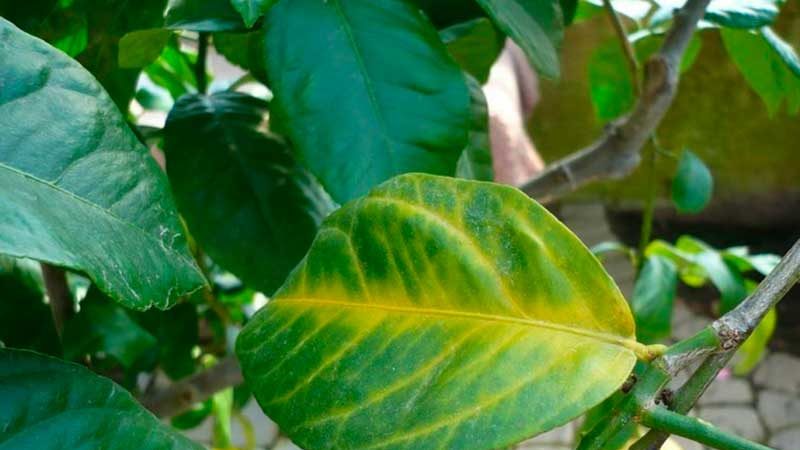
If the leaves begin to dry and fall off, but there is still greenery on the tree, then first of all, you should reconsider your departure and identify possible causes.
Sometimes it is enough to eliminate mistakes in care. This applies to cases where the citrus for a long time lacked light, fertilizer, transplanted into a new pot, or the air is not humid enough.
For other problems, the tree will have to be reanimated:
- Pouring soil. In this case, the lemon is removed from the soil. The roots are cleared of soil and examined. All rotten areas are cut off. The root system is dipped in a light pink solution of potassium permanganate and planted in a new disinfected soil, which is moistened with a small amount of a root formation stimulator. Temporarily reduce watering to 2-3 times a week. A small amount of liquid is poured under the root, sometimes adding a few drops of "Kornevin". The tree is sprayed daily, adding Epin to the water once a week. Such conditions are maintained until new leaves or shoots begin to form.
- Overdried soil. It is impossible to immediately water the lemon with a lot of water, as this will provoke the shedding of the leaves. They begin to moisten the soil in small portions, pouring in 100 g of water every 2 hours. The next time the plant is watered every other day, also in small portions. Further, the usual scheme is used. To help the tree recover, its first week is sprayed twice a day, adding a little "Epin" to the morning solution.
- Stress after changing conditions, hypothermia, citrus recovery after a draft. To reanimate a lemon, it is transplanted into a new soil, poured with Kornevin's solution and sprayed with Epin. They put a bag on the tree and put it in a well-lit place, but not in direct sunlight. The plant is ventilated daily for 10-15 minutes and sprayed with a spray bottle. Once a week add "Epin" to the water for spraying. Use bottom watering by pouring water into a sump under the pot. After the leaf fall stops, and new leaves or shoots begin to form on the plant, the duration of airing is gradually increased, and then the greenhouse is completely disassembled.
Advice! Indoor lemon will recover faster with artificial lighting.
Diseases and their treatment
The dropping of leaves by a citrus plant is not always associated with a violation of the rules of care and unfavorable indoor conditions.Often the problem arises from the lesion of the lemon with diseases. Finding them in most cases is simple, it is enough to know the characteristic symptoms.
Most diseases are easily treated at an early stage. If symptoms are detected too late, then most often the plant dies.

Gommoz
Hommosis is a fungal disease that affects the branches and trunk of a plant. The reproduction of a fungal infection provokes excessive humidity in the air and soil, damage to the bark, deepening of the root collar, and an excess of nitrogen.
The symptoms of the disease are as follows:
- brown spots are formed on the branches and trunk;
- the affected areas die off and crack;
- gum appears from the lesions (sticky, quickly solidifying mass of golden color).
With gommosis, sap flow is disrupted, due to which a sufficient amount of nutrients does not enter the leaves. They wither and fall.
What to do to save lemon from gommosis:
- All spots on the bark of the plant are cut off with a sharp, disinfected knife. If there are too many lesions on the branches, then they are removed.
- Cut off areas are treated with a 3% solution of copper sulfate. Then the whole plant is sprayed with the agent.
- Places of cuts are covered with garden pitch.
The treatment is repeated three times with an interval of 7 days or until the symptoms of the disease disappear.
Root rot
Root rot is another fungal disease. It affects the roots, so the problem is usually noticed when the lemon is already beginning to shed its leaves.
The cause of the disease is considered to be waterlogged soil, watering with cold water, deepening the root collar, planting in contaminated soil.
To get rid of the disease, the following methods are used:
- The tree is dug up. The roots are cleared of the earth.
- The root system is examined. Remove all affected parts.
- The roots are treated with a solution of potassium permanganate or copper sulfate. Soak in the solution from the need for at least half an hour.
- The tree is transplanted into disinfected soil.
A week after transplanting, avoid watering the lemon at the root. Instead, the crown is sprayed daily. After a week, the lemon is watered with a root stimulant.
Tristeza
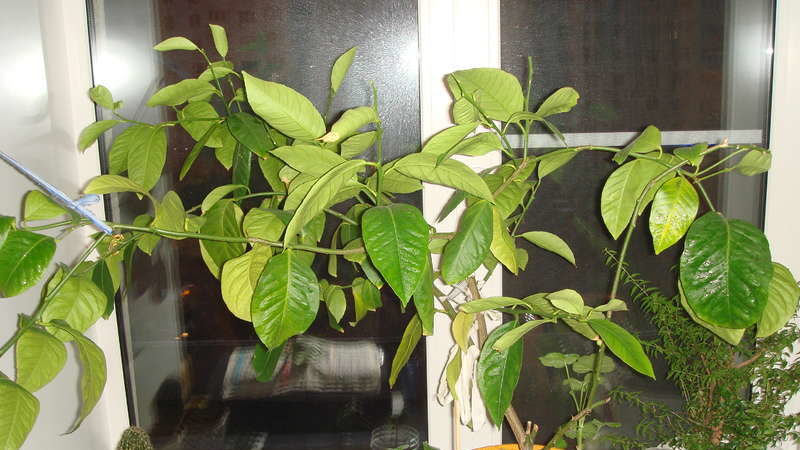
Tristeza is a viral disease. Loss of foliage is thought to be its first symptom. Then the shoots and bark of the plant die off.
Weakened lemons are infected with the disease. It is carried by insects and some types of citrus fruits.
Tristeza is not cured. The infected plant dies.
Melseco
Melseco is another incurable disease. Its main symptoms are shedding of foliage and staining the cut of branches red. Develops with improper care.
Anthracnose
Anthracnose is a disease caused by a fungal infection. It often infects plants at home and causes shedding of foliage.
The list contains its signs:
- leaves turn yellow and fall off;
- plant discards inflorescences and buds;
- young shoots die off;
- red spots appear on the set fruit.
To cure the plant, all affected leaves and shoots are plucked from it. The tree is sprayed with "Fitosporin" or 1% solution of Bordeaux liquid. Processing is carried out at least 3 times.
Pest control
Pests - Another possible reason for the fall of indoor lemon greens. Knowing the basic rules of treatment, it will not be difficult to save citrus.
Insects feeding on the sap of the plant lead to leaf fall. They deprive plants of moisture and nutrients. Three types of such pests are most often found at home.
Spider mite
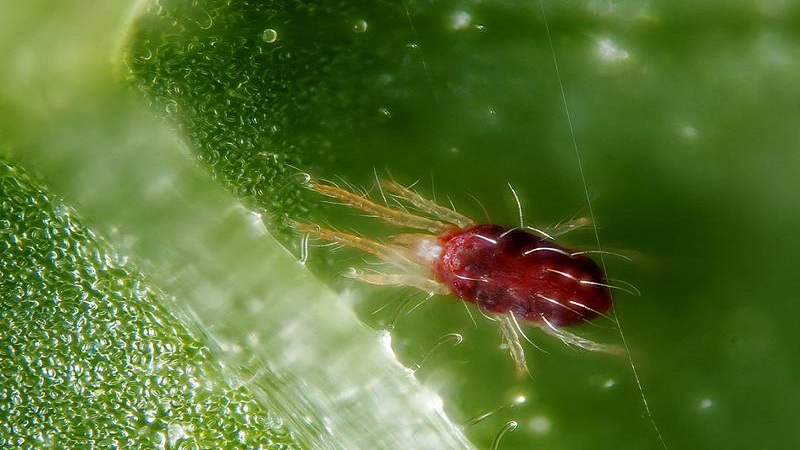
Spider mite is a small pest that often infects plants at home if the air in the room is not humid enough.
The presence of a spider mite is indicated by twisted leaves covered with cobwebs. The pest itself is also easy to find on the seamy side of the leaves.
Fight spider mites as follows:
- The tree is sung under the shower with warm water. The soil is covered with a film so that the chlorinated liquid is not absorbed into it.
- Lemon is sprayed with soapy water, ash infusion or insecticide. Particular attention is paid to the seamy surface of the leaves.
- After three days, the plant is washed again under the shower, washing off the remaining soap solution.
- The procedure is repeated at least 3 times.
Aphid

Aphids feed on plant sap, causing leaves to fall off. It infects lemons with whole colonies. Due to the abundance of insects, it is not difficult to spot them.
Aphids are located on young shoots and on the seamy side of the leaves. The affected areas fade and die.
How to get rid of aphids:
- All leaves and shoots, on which a large number of insects are found, are cut off from the tree. The withered leaves are torn off.
- Lemon is washed in the shower. The earth is covered with a package.
- Each leaf is wiped with a soapy solution with the addition of hot pepper or ash. Do the same with young shoots. The solution is poured into the ground.
- After 5 days, the citrus is rubbed with clean water. Then the dreams are sprayed with soapy water. The procedure is repeated one more time.
Shields
Larvae of scale insects (small bugs) are attached to the bark or seamy side of leaves along the veins. From above they are covered with a strong chitinous layer.
To eliminate them, the following procedures are carried out:
- If possible, remove plant areas with a large number of scutes.
- Prepare a mixture of equal parts of kerosene and water. With the resulting composition, wipe the parts of the plant on which the scale insects remain.
- The tree is sealed with a bag for 2 hours.
- After 2 hours, the plant is washed under the shower.
- Repeat the procedure if necessary.
How to revive and revive a lemon if it has dropped its leaves
If all the leaves have already fallen on the lemon, do not throw it away. First, they examine the tree and feel the shoots. If there are not dry, elastic branches, with a bark under which there is a green layer, then it can still be saved.
How to revive a lemon if it has dropped all the leaves: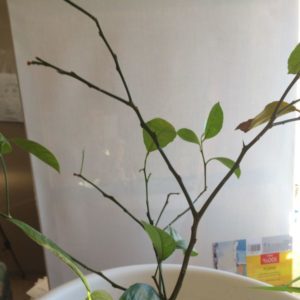
- Lemon is dug out of the ground. The roots are examined. If there are a lot of healthy roots (they should be moist and light at the fracture), then remove all dry and affected parts, and work with the plant further.
- All dry branches are cut. Places of cuts are treated with garden pitch.
- The roots are dipped in Kornevin or another root formation stimulator for 4-6 hours.
- The lemon is transplanted into a new disinfected soil. The soil is moistened with a root formation stimulator. The branches are sprayed with "Epin".
- A bag is put on the tree. Every day it is sprayed with a growth stimulant. For watering, water is poured into a pan.
- The citrus pot is placed on the southern windowsill, shading when the sun is active, or using fluorescent lamps.
- The plant is ventilated daily for 10-15 minutes.
When leaves and shoots begin to form, the duration of airing is increased. The greenhouse is gradually being taken apart.
Conclusion
If a lemon sheds its leaves, it is worth looking for the reason for this phenomenon, since leaf fall is not typical for evergreen citrus fruits. The reason may lie in a violation of the rules of care, damage by diseases and pests.
To save the lemon tree, first identify and fix the root cause of the problem. Then, if necessary, carry out resuscitation measures.